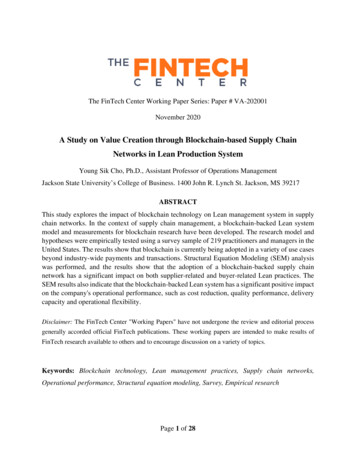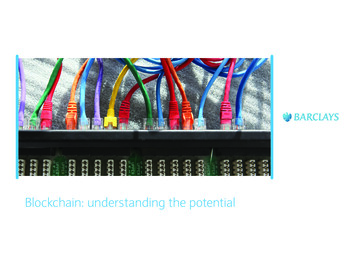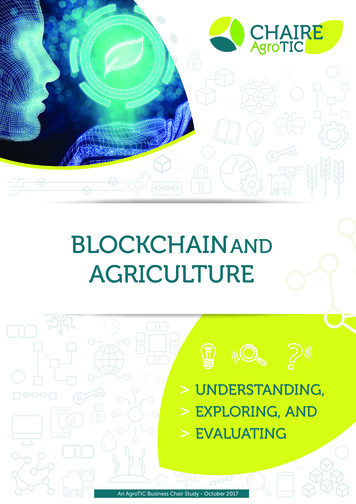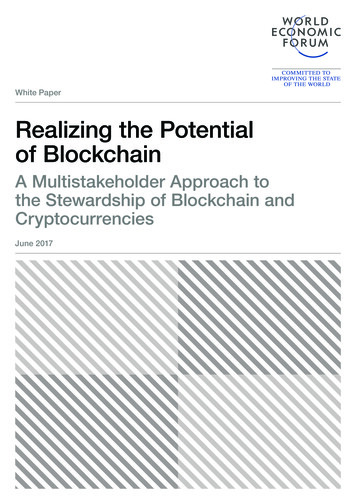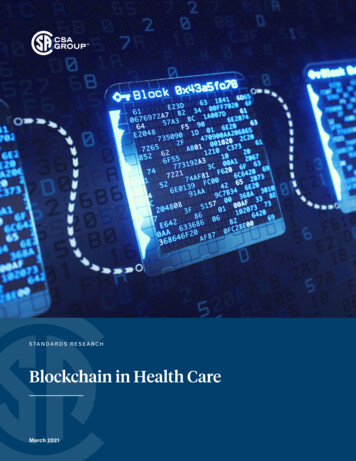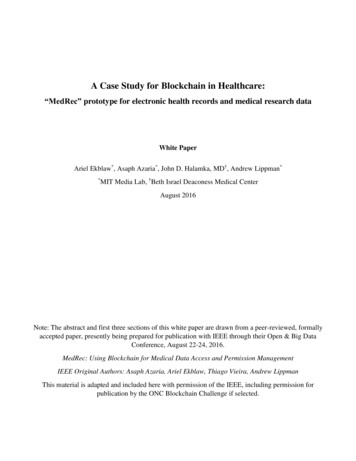
Transcription
A Case Study for Blockchain in Healthcare:“MedRec” prototype for electronic health records and medical research dataWhite PaperAriel Ekblaw*, Asaph Azaria*, John D. Halamka, MD†, Andrew Lippman*MIT Media Lab, †Beth Israel Deaconess Medical Center*August 2016Note: The abstract and first three sections of this white paper are drawn from a peer-reviewed, formallyaccepted paper, presently being prepared for publication with IEEE through their Open & Big DataConference, August 22-24, 2016.MedRec: Using Blockchain for Medical Data Access and Permission ManagementIEEE Original Authors: Asaph Azaria, Ariel Ekblaw, Thiago Vieira, Andrew LippmanThis material is adapted and included here with permission of the IEEE, including permission forpublication by the ONC Blockchain Challenge if selected.
AbstractA long-standing focus on compliance has traditionally constrained development of fundamental designchanges for Electronic Health Records (EHRs). We now face a critical need for such innovation, aspersonalization and data science prompt patients to engage in the details of their healthcare and restoreagency over their medical data. In this paper, we propose MedRec: a novel, decentralized recordmanagement system to handle EHRs, using blockchain technology. Our system gives patients acomprehensive, immutable log and easy access to their medical information across providers andtreatment sites. Leveraging unique blockchain properties, MedRec manages authentication,confidentiality, accountability and data sharing—crucial considerations when handling sensitiveinformation. A modular design integrates with providers' existing, local data storage solutions, facilitatinginteroperability and making our system convenient and adaptable. We incentivize medical stakeholders(researchers, public health authorities, etc.) to participate in the network as blockchain “miners”. Thisprovides them with access to aggregate, anonymized data as mining rewards, in return for sustaining andsecuring the network via Proof of Work. MedRec thus enables the emergence of data economics,supplying big data to empower researchers while engaging patients and providers in the choice to releasemetadata. The purpose of this paper is to expose, in preparation for field tests, a working prototype throughwhich we analyze and discuss our approach and the potential for blockchain in health IT and research.1. IntroductionEHRs were never designed to manage multi-institutional, life time medical records. Patients leavedata scattered across various organizations as life events take them away from one provider's data silo andinto another. In doing so they lose easy access to past data, as the provider, not the patient, generallyretains primary stewardship (either through explicit legal means in over 21 states, or through defaultarrangements in the process of providing care) [1]. Through the HIPAA Privacy Rule, providers can takeup to 60 days to respond (not necessarily to comply) to a request for updating or removing a record thatwas erroneously added [2]. Beyond the time delay, record maintenance can prove quite challenging toinitiate as patients are rarely encouraged and seldom enabled to review their full record [1], [2]. Patientsthus interact with records in a fractured manner that reflects the nature of how these records are managed.Interoperability challenges between different provider and hospital systems pose additionalbarriers to effective data sharing. This lack of coordinated data management and exchange means healthrecords are fragmented, rather than cohesive [3]. Patients and providers may face significant hurdles ininitiating data retrieval and sharing due to economic incentives that encourage “health informationblocking.” A recent ONC report details several examples on this topic, namely health IT developersinterfering with the flow of data by charging exorbitant prices for data exchange interfaces [4].When designing new systems to overcome these barriers, we must prioritize patient agency.Patients benefit from a holistic, transparent picture of their medical history [3]. This proves crucial inestablishing trust and continued participation in the medical system, as patients that doubt theconfidentiality of their records may abstain from full, honest disclosures or even avoid treatment. In theage of online banking and social media, patients are increasingly willing, able and desirous of managingtheir data on the web and on the go [3]. However, proposed systems must also recognize that not allprovider records can or should be made available to patients (i.e. provider psychotherapy notes, orphysician intellectual property), and should remain flexible regarding such record-onboarding exceptions[5], [6].
Medical records also prove critical for research. The ONC's report emphasizes that biomedical andpublic health researchers “require the ability to analyze information from many sources in order to identifypublic health risks, develop new treatments and cures, and enable precision medicine” [4]. Though somedata trickles through to researchers from clinical studies, surveys and teaching hospitals, we note agrowing interest among patients, care providers and regulatory bodies to responsibly share more data,and thus enable better care for others [7], [4].In this work, we explore a blockchain structure applied to EHRs. We build on this distributedledger protocol originally associated with Bitcoin [8]. The blockchain uses public key cryptography tocreate an append-only, immutable, timestamped chain of content. Copies of the blockchain are distributedon each participating node in the network. The Proof of Work algorithm used to secure the content fromtampering depends on a “trustless” model, where individual nodes must compete to solvecomputationally-intensive “puzzles” (hashing exercises) before the next block of content can be appendedto the chain. These worker nodes are known as “miners,” and the work required of miners to append blocksensures that it is difficult to rewrite history on the blockchain.Our MedRec blockchain implementation addresses the four major issues highlighted above:fragmented, slow access to medical data; system interoperability; patient agency; improved data qualityand quantity for medical research. We build on the work of Zyskind et al. [9] to assemble references todata and encode these as hashed pointers onto a blockchain ledger. We then organize these references toexplicitly create an accessible bread crumb trail for medical history, without storing raw medical data onthe blockchain. Our system supplements these pointers with on-chain permissioning and data integritylogic, empowering individuals with record authenticity, auditability and data sharing. We build robust,modular APIs to integrate with existing provider databases for interoperability. A novel data-miningscheme is proposed to sustain the MedRec network and bring open, big data to medical researchers. Wepresent MedRec not as the panacea for medical record management, but as a foray into this space todemonstrate innovative EHR solutions with blockchain technology.2. System Implementation2.1 OverviewFor MedRec, the block content represents data ownership and viewership permissions shared bymembers of a private, peer-to-peer network. Blockchain technology supports the use of “smart contracts,”which allow us to automate and track certain state transitions (such as a change in viewership rights, orthe birth of a new record in the system). Via smart contracts on an Ethereum blockchain [10], we logpatient-provider relationships that associate a medical record with viewing permissions and data retrievalinstructions (essentially data pointers) for execution on external databases. We include on the blockchaina cryptographic hash of the record to ensure against tampering, thus guaranteeing data integrity. Providerscan add a new record associated with a particular patient, and patients can authorize sharing of recordsbetween providers. In both cases, the party receiving new information receives an automated notificationand can verify the proposed record before accepting or rejecting the data. This keeps participants informedand engaged in the evolution of their records.MedRec prioritizes usability by also offering a designated contract which aggregates references toall of a user's patient-provider relationships, thus providing a single point of reference to check for anyupdates to medical history. We handle identity confirmation via public key cryptography and employ aDNS-like implementation that maps an already existing and widely accepted form of ID (e.g. name, or
social security number) to the person's Ethereum address. A syncing algorithm handles data exchange“off-chain” between a patient database and a provider database, after referencing the blockchain toconfirm permissions via our database authentication server.In the following sections we present the design principles of our distributed system and itsimplementation.2.2 Blockchain BackgroundOriginally designed for keeping a financial ledger, the blockchain paradigm can be extended toprovide a generalized framework for implementing decentralized compute resources [10]. Each computeresource can be thought of as a singleton state-machine that can transition between states viacryptographically-secured transactions. When generating a new state-machine, the nodes encode logicwhich defines valid state transitions and upload it onto the blockchain. From there on, the blocks journala series of valid transactions that, when incrementally executed with the state from the previous block,morph the state-machine into its current state. The Proof of Work consensus algorithm and its underlyingpeer-to-peer protocol secure the state-machines' state and transitioning logic from tampering, and alsoshare this information with all nodes participating in the system. Nodes can therefore query the statemachines at any time and obtain a result which is accepted by the entire network with high certainty.This transaction-based state-machine generalization of the blockchain is informally referred to assmart contracts. Ethereum is the first to attempt a full implementation of this idea. It builds into theblockchain a Turing-complete instruction set to allow smart-contract programming and a storagecapability to accommodate on-chain state. We regard the flexibility of its programming language as animportant property in the context of EHR management. This property can enable advanced functionality(multi-party arbitration, bidding, reputation, etc.) to be coded into our proposed system, adapting tocomply with differences in regulation and changes in stakeholders needs.We utilize Ethereum's smart contracts to create intelligent representations of existing medicalrecords that are stored within individual nodes on the network. We construct the contracts to containmetadata about the record ownership, permissions and data integrity. The blockchain transactions in oursystem carry cryptographically signed instructions to manage these properties. The contract's statetransition functions carry out policies, enforcing data alternation only by legitimate transactions. Suchpolicies can be designed to implement any set of rules which govern a particular medical record, as longas it can be represented computationally. For example, a policy may enforce that separate transactionsrepresenting consent are sent from both patients and care providers, before granting viewing permissionsto a third party.To navigate the potentially large amount of record representations, our system structures them onthe blockchain by implementing three types of contracts. Figure 1 illustrates the contract structures andrelationships.
2.3 Smart Contract Structures2.3.1 Registrar Contract (RC)This global contract maps participantidentification strings to their Ethereum addressidentity (equivalent to a public key). Weintentionally use strings rather than thecryptographic public key identities directly,allowing the use of already existing form of ID.Policies coded into the contract can regulateregistering new identities or changing themapping of existing ones. Identity registrationcan thus be restricted only to certifiedinstitutions. The RC also maps identity stringsto an address on the blockchain, where aspecial contract described below, called theSummary Contract, can be found.Figure 1. MedRec smart contracts on the left, showing datacontent for each contract type. Sample relationship graphbetween contracts and network nodes on the right.2.3.2 Patient-Provider Relationship Contract (PPR)A Patient-Provider Relationship Contract is issued between two nodes in the system when onenode stores and manages medical records for the other. While we use the case of care provider and patient,this notion extends to any pairwise data stewardship interaction. The PPR defines an assortment of datapointers and associated access permissions that identify the records held by the care provider. Each pointerconsists of a query string that, when executed on the provider's database, returns a subset of patient data.The query string is affixed with the hash of this data subset, to guarantee that data have not been alteredat the source. Additional information indicates where the provider's database can be accessed in thenetwork, i.e. hostname and port in a standard network topology. The data queries and their associatedinformation are crafted by the care provider and modified when new records are added. To enable patientsto share records with others, a dictionary implementation (hash table) maps viewers’ addresses to a list ofadditional query strings. Each string can specify a portion of the patient's data to which the third partyviewer is allowed access.Our prototype demonstrates this design with SQL data queries. In a simple case, the providerreferences the patient's data with a simple SELECT query conditioned on the patient's address. Forpatients, we designed a tool which allows them to check off fields they wish to share through our graphicalinterface. Under the hood, our system formulates the appropriate SQL queries and uploads them to thePPR on the blockchain. Note that by using generic strings our design can robustly interface with any stringqueried database implementation. Hence, it can conveniently integrate with existing provider data storageinfrastructure. At the same time, patients are enabled with fine-grained access control of their medicalrecords, selecting essentially any portion of it they wish to share.2.3.3 Summary Contract (SC)This contract functions as a bread crumb trail for participants in the system to locate their medicalrecord history. It holds a list of references to Patient-Provider Relationship contracts (PPRs), representingall the participant's previous and current engagements with other nodes in the system. Patients, forinstance, would have their SC populated with references to all care providers they have been engaged
with. Providers, on the other hand, are likely to have references to patients they serve and third-partieswith whom their patients have authorized data sharing. The SC persists in the distributed network, addingcrucial backup and restore functionality. Patients can leave and rejoin the system multiple times, forarbitrary periods, and always regain access to their history by downloading the latest blockchain from thenetwork. As long as there are nodes participating in the network, the blockchain log is maintained.The SC also implements functionality to enable user notifications. Each relationship stores a statusvariable. This indicates whether the relationship is newly established, awaiting pending updates and hasor has not acknowledged patient approval. Providers in our system set the relationship status in theirpatients' SC whenever they update records or as part of creating a new relationship. Accordingly, thepatients can poll their SC and be notified whenever a new relationship is suggested or an update isavailable. Patients can accept, reject or delete relationships, deciding which records in their history theyacknowledge.Our prototype ensures that accepting or rejecting relationships is done only by the patients. Toavoid notification spamming from malicious participants, only providers can update the status variable.These administration principles can be extended, adding additional verifications to confirm proper actorbehavior.2.4 System Node DescriptionWe design the components of oursystem nodes to integrate with existing EHRinfrastructure. We assume that many nodes,and in particular care providers, alreadytrustfully manage databases with patientdata stored on servers with networkconnectivity. Our design introduces foursoftware components: Backend Library,Ethereum Client, Database Gatekeeper andEHR Manager. These can be executed onservers, combining to create a coherent,distributed system. We provide a prototypeimplementation of these components thatintegrates with a SQLite database and ismanaged through our web user interface.Notably, any provider backend and userinterface implementations can participate inthe system by employing the modularinteroperability protocol as defined throughour blockchain contracts.Figure 2. System orchestration example: provider adds a record fornew patient.Patient nodes in our system contain the same basic components as providers. An implementationof these can be executed on a local PC or even a mobile phone. Their local database can be one of manylightweight database implementations. The databases can function merely as cache storage of the patient'smedical data. Missing data can be retrieved from the network at any time by following the node's SummaryContract.
2.5 Primary Software Modules2.5.1 Backend API LibraryWe construct multiple utilities, bundled in a backend library, to facilitate the system's operation.Our library abstracts the communications with the blockchain and exports a function-call API. Recordmanagement applications and their user interfaces can thus avoid the hurdles of working directly with theblockchain. One such hurdle is verifying that each sent transaction is accepted with high confidence bythe network. Our library automatically handles the uncertainty of when transactions are mined and dealswith cases when they are discarded. The backend library interacts with an Ethereum client to exercise thelow-level formatting and parsing of the Ethereum protocol.Steps 1 and 2 in Figure 2 illustrate our backend implementation of a scenario where a provideradds a record for a new patient. Using the Registrar Contract on the blockchain, the patient's identifyinginformation is first resolved to their matching Ethereum address and the corresponding Summary Contractis located. Next, the provider uploads a new PPR to the blockchain, indicating their stewardship of thedata owned by the patient's Ethereum address. The provider node then crafts a query to reference this dataand updates the PPR accordingly. Finally, the node sends a transaction which links the new PPR to thepatient's Summary Contract, allowing the patient node to later locate it on the blockchain.2.5.2 Ethereum ClientThis component implements the full functionality required to join and participate in the Ethereumblockchain network. This handles a broad set of tasks, such as connecting to the peer-to-peer network,encoding and sending transactions and keeping a verified local copy of the blockchain. For our prototypeimplementation we use PyEthereum and the PyEthApp client.We modify the client to be aware of our mapping of identity and addresses. We then implement aservice to locate the node's Summary Contract (SC), via Registrar Contract address lookup. This serviceruns continuously within the client to monitor real-time changes to the SC. In the event of an update, theservice signals the EHR Manager to issue a user notification and, if necessary, sync the local database.Steps 4 to 6 in Figure 2 continue the use case described above from the patient node perspective.The patient's modified Ethereum client continuously monitors her SC. Once a new block is mined withthe newly linked PPR, the client issues a signal which results in a user notification. The user can thenacknowledge or decline her communication with the provider, updating the Summary Contractaccordingly. If the communication is accepted, our prototype implementation automatically issues a queryrequest to obtain the new medical data. It uses the information in the new PPR to locate the provider onthe network and connect to its Database Gatekeeper server.2.5.3 Database GatekeeperThe Database Gatekeeper implements an off-chain, access interface to the node's local database,governed by permissions stored on the blockchain. The Gatekeeper runs a server listening to queryrequests from clients on the network. A request contains a query string, as well as a reference to theblockchain PPR that warrants permissions to run it. The request is cryptographically signed by the issuer,allowing the gatekeeper to confirm identities. Once the issuer's signature is certified, the gatekeeper checksthe blockchain contracts to verify if the address issuing the request is allowed access to the query. If theaddress checks out, it runs the query on the node's local database and returns the result over to the client.
Steps 7 to 9 in Figure 2 illustrate how a patient retrieves personal data from the provider node.Note that our components similarly support third-parties retrieving patient-shared data: the patient selectsdata to share and updates the corresponding PPR with the third-party address and query string. Ifnecessary, the patient's node can resolve the third party address using the Registrar Contract on theblockchain. Then, the patient node links their existing PPR with the care provider to the third-party'sSummary Contract. The third party is automatically notified of new permissions, and can follow the linkto discover all information needed for retrieval. The provider's Database Gatekeeper will permit access tosuch a request, corroborating that it was issued by the patient on the PPR they share.2.5.4 EHR ManagerWe tie together all the software components previously mentioned with our EHR management anduser interface application. The application renders data from local SQLite databases (designed to beinterchangeable with other DB software) for viewing, and presents the users with update notifications,and data sharing and retrieval options. Our user interface prioritizes intuitive, crisp, and informativedesign, as recommended by the Department of Veteran Affairs and ONC’s Blue Button designcompetition [11]. Our application is conveniently accessed through a web interface, built on a pythonbackend framework. We are especially cognizant of compatibility for mobile devices, as modern usersexpect easy access and high quality experiences while on-the-go.2.6 MedRec Blockchain MiningWe incentivize “miners” to participate in the network and contribute their computational resourcesto achieve a trustworthy, gradual advancement of the chain. We propose a model that engages thehealthcare community in network stewardship—MedRec brings medical researchers and health carestakeholders to mine in the network. In return, the network beneficiaries, i.e. providers and patients,release access to aggregate, anonymized medical data as mining rewards. We explore this idea in ourprototype by implementing a special function in the PPR contract. It requires care providers to attach abounty query to any transaction they send updating the PPR. For example, this bounty query can beformulated to return the average iron levels in blood tests done by the provider, across all patients, in theprevious week. When the block containing the record-update transaction is mined, the mining functionautomatically appends the block's miner as the owner of the bounty query. The miner can then collect itby simply issuing a request for this bounty to the provider's Database gatekeeper. Because it is signed bythe provider as part of the transaction, the bounty query is safe from malicious alterations. This “bountyquery” or data reward for mining enables medical researchers to access population-level insights intomedical treatment and healthcare outcomes, potentially revolutionizing how data is gathered and accessedfor research purposes. We envision future updates to the mining model where miners can specifypreferences for demographic cohorts and features of the data they are looking for, in order to enableprecision medicine and targeted research (while still preserving the privacy of the patients).3. Prototype EvaluationMedRec gives patients an immutable log of their medical history, which is not onlycomprehensive, but also accessible and credible. This restores patient agency, as participants are nowmore fully informed of their medical history and any modifications to it. Through permission managementon the blockchain, we enable patient-vetted data exchange between medical jurisdictions and aninteroperable content management system for the physicians supervising these records. The blockchainledger keeps an auditable history of medical interactions between patients and providers, likely relevant
for regulators and payers (e.g. insurance) in the future. Below, we consider the security, privacy andinteroperability implications of this project and discuss our in-situ deployment testing.First, on robustness and security: our blockchain implementation enjoys several key properties ofdecentralization. MedRec enjoys a strong failover model, relying on the many participating entities in thesystem to avoid a single point of failure. Medical records are stored locally in separate provider and patientdatabases; copies of authorization data are stored on each node in the network. Because both the rawmedical data and global authorization log stay distributed, our system does not create a central target forcontent attack—a crucial consideration in an age of cyberattacks and data leaks. Though some blockchainsexperience robustness challenges from a scaling limit on the “block size” or storage capacity [12], theseparameters can be modified to optimize for other performance requirements in a private blockchainnetwork. Notably, MedRec does not claim to address the security of individual provider databases—thismust still be managed properly by the local IT system admin. Nor does MedRec attempt to solve theDigital Rights Management [13] problem of undesired data copying, as our system assumes providernodes that are bound by external regulation governing data copying in the medical use case, e.g. HIPAA.Regarding privacy, use of blockchain technology introduces several limitations. Thepseudonymous property of transactions currently allows for data forensics, or inferring patterns oftreatment from frequency analysis. Without any disclosure of name or PII, one could infer that some entityhas repeatedly interacted with another network entity through analysis of network traffic. Improvingobfuscation while preserving auditability on the blockchain is an ongoing area of exploration. Onepotential solution is to make the blockchain a “permissioned” structure, where only pre-approved, whitelisted nodes are allowed read access to the ledger. This would prevent rogue actors from extractingfrequency-based insights from the blockchain records. Furthermore, encryption can be introduced in theoff-blockchain data syncing steps to safeguard against accidental or malicious content access. Whileoutside the scope of the initial prototype (but unarguably crucial for future development), a rigorous kanonymity analysis [14] of privacy-preserving query construction is needed, for release of the aggregatedresearch data to medical research “miners.”Regarding interoperability: by integrating with providers' existing data storage infrastructure, wefacilitate continued use of their existing systems. We believe this will ease adoption and aid compliancewith HIPAA regulations. Building on the principle of interoperability, we have designed the system withflexibility to support open standards for health data exchange—be that FHIR or other flavors of HL7proposals in the future [15]. In addition, MedRec is source agnostic, i.e. able to receive data from anynumber of endpoints (physician offices, hospital servers, patient home computers, et cetera). We havedeveloped MedRec not as a proprietary system, but as a set of open APIs to facilitate EHR review andexchange. MedRec is a layer that can be added to existing provider backends (see discussion below ofintegration with EPIC and Cerner systems) with minimal orchestration, thanks to the embedded logic inour Database Gatekeeper utility.To test our system’s interoperability with an in-situ provider’s backend systems and data files, wehave partnered with Beth Israel Deaconess Medical Center (Harvard Medical School Teaching Hospital).We are evaluating MedRec’s ability to smoothly intake and parse a standard clinical document, link ourDatabase Gatekeeper utility to the relevant Beth Israel endpoint and test an end-to-end system flow fromthe hospital’s existing user interface for physicians through our backend and out to a sample patient node.[End of material adapted from IEEE Conference submission “MedRec: Using Blockchain for Medical Data Access and Permission Management”]
4. MedRec in the Context of National Healthcare PrioritiesAs mentioned in the introduction, we do not present MedRec as a panacea nor as the onlyblockchain-mediated solution that would be needed to achieve our stated goals of data access, patientempowerment, interoperability and improved medical research. In the analysis below, we refer to MedRecby name to suggest how such a project might address national healthcare priorities, likely as part of alarger suite of blockchain solutions to which we hope to
A Case Study for Blockchain in Healthcare: “MedRec” prototype for electronic health records and medical research data White Paper Ariel Ekblaw*, Asaph †Azaria*, John D. Halamka, MD , Andrew Lippman* *MIT Media Lab, †Beth Israel Deaconess Medical Center August 2016 Note: The abstract and first three sections of

